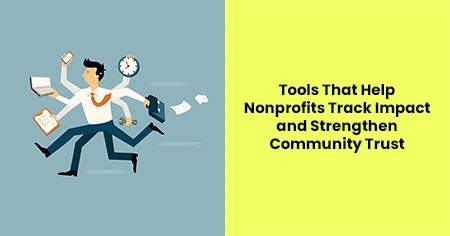No matter the mission, nonprofit teams must show stakeholders that their resources are being used meaningfully. From food banks to literacy programs, organizations are shifting away from spreadsheets and instinct to systems that offer measurable, real-time insights. These tools help bridge the gap between effort and accountability, which can deepen relationships with both funders and communities.
Centralizing Metrics for Clarity
Data scattered across multiple platforms slows progress and leaves room for human error. A central system makes it easier to track programs, events, outreach, and financials all in one place. This approach reduces friction between departments and keeps everyone focused on common objectives.
Clear dashboards and reports offer visibility at every level—from volunteers checking in attendance logs to board members reviewing annual outcomes. When staff can spot trends early, they adjust and allocate resources more effectively. A community arts nonprofit might notice decreased attendance in a youth program before it becomes a pattern. These early warnings are invaluable for staying responsive and focused.
Real-Time Feedback From the Field
Field workers and volunteers have firsthand knowledge of what’s working and what’s not. Tools that allow them to submit updates, photos, and notes on-site give headquarters an instant pulse on program delivery. This kind of feedback loop strengthens internal communication and reduces delays in decision-making.
Nonprofits that rely on mobile outreach or distributed teams especially benefit from this immediacy. When a disaster response team uploads real-time updates, others can see which locations have been served and where urgent needs remain. Time-sensitive data improves logistics, reduces duplication, and helps allocate efforts where they’ll have the most impact.
Showing Funders Their Money at Work
Donors aren’t just writing checks. They’re forming relationships with missions that matter to them. Tools that visualize where money goes, what results it achieves, and how programs grow over time make it easier to build long-term trust.
With the right tools, a nonprofit can create a shareable story with data points and visuals to match. Whether through automated impact reports or donor-specific updates, funders receive evidence of success without waiting for the annual report. Transparency like this boosts confidence and encourages repeat giving.
Strengthening Accountability Through Automated Reporting
Automated reporting systems reduce the time spent compiling numbers and increase accuracy across all metrics. Staff can focus on the story behind the data rather than scrambling to find it. This matters not only to donors but also to governing bodies and grant institutions that require ongoing documentation.
Dashboards built around key performance indicators—client outcomes, service reach, participation rates—offer a snapshot of progress at any moment. When results are easy to understand, teams stay motivated, and external partners stay informed.
Helping Small Teams Do Big Things
Smaller nonprofits often feel they lack the time or budget to invest in advanced tools. But lightweight, affordable software can replace hours of manual work, freeing staff to focus on what they do best.
Simple automation like email triggers, appointment schedulers, and donation tracking cuts down administrative time. And with more platforms offering nonprofit discounts, these tools are becoming more accessible. This helps organizations grow without sacrificing the personal touches that make them unique.
Building Community Confidence Through Transparency
Trust builds slowly, and a single communication misstep can set back months of progress. Public dashboards, newsletters with performance stats, or transparent project timelines show communities that promises are being kept.
Even when goals shift, being open about changes reinforces reliability. Sharing both successes and setbacks proves that an organization is learning and adapting. This honesty helps create a shared sense of ownership between nonprofits and those they serve.
Managing Volunteers More Intelligently
Volunteers are an integral part of nonprofit success, but coordinating them can be complicated. Scheduling platforms and participation trackers help match volunteers to the right tasks and prevent burnout.
When volunteer hours and feedback are properly recorded, organizations can highlight contributions more accurately. Recognizing these efforts not only boosts morale. It gives potential volunteers insight into how they can get involved.
Using CRM Systems to Personalize Relationships
Customer relationship management (CRM) tools aren't just for sales teams. In the nonprofit world, they help manage relationships with donors, volunteers, beneficiaries, and partners. These platforms let staff store interaction histories, tailor outreach, and set reminders for follow-ups.
Personalized communication builds trust. Whether it’s a thank-you message after a donation or a call to action timed to a specific campaign, these touches make supporters feel seen and valued. They help prevent missed opportunities by keeping contact records up to date.
Adopting Software That Integrates Across Functions
One of the most effective ways to streamline nonprofit work is to use tools that integrate across departments, combining data from marketing, fundraising, service delivery, and administration. Organizations can learn more here or at any other reputable website that streamlines their nonprofit operations with specialized software, helping to avoid the inefficiencies caused by disconnected systems. Integrations improve visibility and coordination without creating more complexity.
When staff members don’t have to jump between five platforms just to find one piece of information, they work faster and with greater clarity. Integrated systems offer a smoother workflow and ensure all teams are speaking the same language.
Tracking Long-Term Impact, Not Just Outputs
It's one thing to say how many meals were served or workshops hosted. It’s another to measure how lives changed because of those services. Impact-tracking tools go beyond numbers—they help uncover deeper patterns and outcomes.
This kind of long-term data gives nonprofits the ability to refine programs and report on true change. Instead of just noting that 200 students attended a literacy course, a nonprofit can report how many reached grade-level reading ability within six months. That kind of insight shifts conversations from activities to results.
Aligning Technology With Mission
Technology should never drive the mission—it should serve it. Organizations that choose tools aligned with their specific goals make better use of their time and resources.
Rather than chasing the latest features, successful teams pick platforms that match their workflows and enhance their strengths. The right solution is one that staff will actually use, that simplifies daily tasks, and that brings them closer to the people they serve.
Careful implementation and training are just as important as the tools themselves. When everyone knows how to use the system, organizations get better data, stronger insights, and more compelling stories to share.
Cultivating Ongoing Trust With Stakeholders
The impact is not just measured by outcomes but by relationships. When people feel confident in an organization’s transparency and consistency, they become more engaged. Tools alone can’t build that trust, but they make it easier to demonstrate it through facts, updates, and responsiveness.
Community members, donors, and staff all benefit from knowing that progress is tracked, reported, and acted on. This consistency builds a culture of responsibility where everyone plays a part in the mission’s success.
Encouraging Smarter Grant Management
Many nonprofits depend on grant funding, but managing grant cycles, compliance deadlines, and reporting requirements can become overwhelming without the right system. Dedicated grant management tools simplify the application process, track deliverables, and create a timeline of obligations that’s easy to follow.
This clarity helps avoid missed deadlines or misallocated funds, which can jeopardize future funding opportunities. Grant officers gain a better overview of which projects align with funding priorities, while finance teams can track expenditures against specific grant allocations with accuracy. With stronger oversight, organizations stay compliant and confident in audits and evaluations.
Supporting Program Growth With Scalable Tools
What works for a small nonprofit with a local focus may not be enough once that organization begins expanding. Scalable tools make it possible to grow services without disrupting daily operations. From managing multilingual outreach to coordinating efforts across multiple locations, these systems give nonprofits room to evolve.
When teams don’t have to reinvent workflows each time they add a program or geographic focus, they retain consistency while reaching more people. Growth doesn’t have to mean complexity—just better systems that grow alongside the mission.
Reducing Staff Burnout Through Smarter Workflows
Nonprofit teams are often stretched thin, wearing multiple hats to meet growing demands. Repetitive manual tasks—like data entry, scheduling, or email follow-ups—contribute to burnout. Automating these tasks gives staff more time to focus on work that requires human care and judgment.
Smart workflows reduce friction in everyday processes. A well-structured intake form, automated volunteer onboarding, or pre-scheduled donor outreach removes the need for last-minute scrambling. When the load feels manageable, morale improves, and turnover decreases, giving organizations more stability over time.
Investing in the right tools is no longer optional—it’s a necessity. Whether managing volunteers, tracking long-term impact, or maintaining strong donor relationships, modern systems give organizations the ability to operate more efficiently and communicate more clearly. These tools don’t replace human connection or compassion; instead, they support and strengthen the work that people do by reducing errors, saving time, and uncovering insights that might otherwise go unnoticed.
More importantly, the right technology helps nonprofits earn and maintain the trust of their communities. Stakeholders are more likely to support organizations that can clearly show how their contributions—whether time, money, or expertise—translate into real-world change. When nonprofits embrace tools that align with their mission and scale with their growth, they’re better positioned to respond to challenges, demonstrate accountability, and foster lasting relationships.








